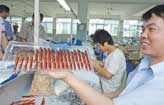Photos
Astronauts on last spacewalk of shuttle era
Updated: 2011-07-13 06:27
(Agencies)
CAPE CANAVERAL, Florida - Astronauts making the last spacewalk of NASA's space shuttle era on Tuesday retrieved a broken pump from the International Space Station and installed a fill-er-up experiment for a robot.
The space station's two-armed robot Dextre won't tackle the $22.6 million playset - a fancy Fisher-Price toy as one astronaut describes it - until long after Atlantis departs and the shuttle program ends.
But perhaps more than anything else on this final journey by a shuttle, the robotic demo illustrates the possibilities ahead for NASA: satellite-refueling stations in space run by robots.
In a departure from previous shuttle visits, the spacewalking job fell to space station astronauts, Michael Fossum and Ronald Garan Jr., who teamed up for three spacewalks in 2008. The four-person Atlantis crew is the smallest in decades, and so the lone spacewalk of the mission was handed over to the full-time station residents.
It was the 160th spacewalk in the 12{-year life of the orbiting outpost, and the last one planned for Americans for nearly a year.
"To see that we've really done it, it's just awe-inspiring," Fossum said of the completed space station and all the spacewalks that went into it. "Ron and I are honored to be a part of it, to help close out one of the final chapters."
Fossum and Garan completed the two major chores - the pump removal and robotic test hookup - inside of 3 hours. They spent the rest of the 6-hour spacewalk on a variety of small tasks.
The two paused during their spacewalk to admire the view 245 miles (400 kilometers) below - Kennedy Space Center - and on the next swing around the world, Houston, home to Mission Control.
"Hello Kennedy, beautiful launch," Fossum called out. Atlantis departed Kennedy on Friday on the very last shuttle launch.
The ammonia coolant pump stopped working last July and, for more than two weeks, left the space station with only half its cooling capability. Space station residents had to perform three emergency spacewalks last summer to replace the pump and restore full cooling to all the on-board equipment.
NASA wants the pump brought back to Earth so engineers can figure out why it failed to help them keep the on-board station pumps running. The space station is intended to operate until at least 2020.
Garan gripped the pump as the space station's robot arm maneuvered him over to Atlantis. The pump was anchored in the shuttle's payload bay, ready for next week's ride home.
As they turned their attention to the robotic experiment, the spacewalkers thanked all the thousands of people who worked on the shuttle. "It is really beautiful," Garan said.
The robotic workbench - which the astronauts attached to a shelf on Dextre's base - consists of a 3-foot (1 meter) box holding four customized tools, including a wire cutter and a safety cap removal device, as well as an assortment of knobs, caps, valves and a half gallon of ethanol.
Dextre - a hulking metal robot with 11-foot (3.35-meter) arms - will release locks on the tools in August but won't try out the workbench until January.
The designers of the experiment - based at Goddard Space Flight Center in Greenbelt, Maryland - envision robots one day using these methods to fill the fuel tanks of satellites orbiting as high as 22,300 miles (35,886 kilometers). That would keep the spacecraft operating longer, instead of becoming expensive pieces of space junk. What's more, spacecraft bound for distant worlds could fill up after launch, thereby flying more payloads because of the savings in fuel weight.
While the spacewalk unfolded, the majority of the eight astronauts inside worked to unload the nearly 5 tons of supplies that were delivered in a giant cargo carrier by Atlantis. It represents a year's worth of food, clothes and other housekeeping items, to tide the crew over in case commercial rocket makers fall behind in their own cargo runs. The first such haul is supposed to take place by year's end.
Until now, the shuttle has hoisted the bulk of supplies to the space station. Cargo runs by Russia, Japan and Europe will continue.
NASA is turning to private enterprise in the post-shuttle period, so it can meet the White House goal of sending astronauts to an asteroid by 2025 and Mars the decade after that.
The 13-day flight by Atlantis is the last for the 30-year shuttle program. Atlantis is due to return July 21 to Kennedy, where it will go on display at a tourist center.

Specials

90th anniversary of the CPC
The Party has been leading the country and people to prosperity.

The write stuff
'Pen capital' goes back to drawing board for answers to economic changes taking shape in Zhejiang

Say hello to hi panda
An unusual panda is the rising star in Europe's fashion circles
